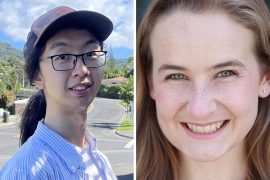The many interfaces of computing

The new MIT Stephen A. Schwarzman College of Computing will incorporate the modern tools of computing into disciplines across the Institute. “The college will equip students to be as fluent in computing and AI [artificial intelligence] as they are in their own disciplines — and ready to use these digital tools wisely and humanely to help make a better world,” says MIT President Rafael Reif.
As often happens, it appears MIT students are already there. We recently spoke with six undergraduate students who are participating in the Advanced Undergraduate Research Opportunities Program (SuperUROP), and found them already thinking deeply about how new computational technologies can be put to use in fields outside of computer science. These students are working on a huge range of problems that share a common theme: Solving them will provide tangible benefits to society.
Haripriya Mehtais working to augment human creativity by using machine learning algorithms to provide potential storylines and helpful drawings for blocked artists. Upon arrival at MIT, Mehta knew she wanted to focus on assistive technology to help people. She was originally interested in prosthetics but soon realized there are more ways than one to assist people.
“I’ve always been a raconteur of sorts, whether it’s writing or dancing or playing the piano, and the idea of creative blocks has always interested me,” says Mehta, a third-year student in electrical engineering and computer science. “I want to explore how we can use deep learning to assist artists when we are sort of lost. It would be almost as if you’re having a conversation with another artist but instead of an artist, it’s a neural net.”
Mehta described widespread application of such a machine learning model: storyboarding for artists; a creative task for elderly to stave off early onset Alzheimer’s; an early childhood education tool to help children form sentences, create stories, and draw.
Senior Christabel Jemutai Sitienei is seeking to drive financial inclusion in East Africa through artificial intelligence. Growing up she witnessed the mobile money industry spread across Kenya and fuel economic growth. More than 75 percent of adults in Kenya were able to open a bank account because of it. Now Sitienei wants to help Kenyans gain access to additional financial services and heightened business acumen.
“Born and bred in Kenya, and with my exposure to AI, I’m in a unique and privileged position to understand the problem,” she says. “I would like to design an app that informs decision making and saves money. It would change how people are building infrastructure and deploying resources.”
Sitienei came to MIT intent on studying mechanical or systems engineering. All that changed in her sophomore year when she developed a mobile app to help her parents in Kenya run their farm.
“When I started using my computing knowledge to solve my own problems, I just knew this was for me,” says Sitienei, who adopted electrical engineering and computer science (EECS) as a major. “The application I built for my parents has been so valuable to them even until now. I learned that I really like solving problems that I can relate to,” she says.
Gabe Margolis is developing machine learning methods for fast and accurate prediction of seafloor feature maps based on sparse data collected by autonomous underwater vehicles.
A third-year student in aeronautics and astronautics, Margolis knew from the outset he wanted to focus on cognitive robotics at MIT. He soon realized that EECS was not his only option. “It seems like the major that best represents my interests would be computer science — but there’s actually a big application of artificial intelligence and autonomous systems in aerospace too,” he says.
“I realized the artificial intelligence aspects of aerospace engineering are really about exploring the unknown and that is something I think is really cool,” says Margolis.
Mathematics major Andy Wei is tackling machine learning and security. Wei, a fourth-year student, is combining his math and computer science skills to address things like data poisoning, which occurs when attackers inject a small amount of adversarial training data to compromise a neural network.
“If we’re deploying neural networks, we better have a good understanding of how they are vulnerable to adversarial examples,” he says, describing the risks posed by inputs that are misclassified by the network but indistinguishable from natural data to the human eye.
“If people can somehow toy with the system and make some tweaks and the machine fails, that’s an important security issue to understand. I’m really excited to tackle the problem.”
And Mattie Wasiak is applying data analytics to health care. She is leveraging clinical data sets to optimize oxygen delivery to newborns. “I am excited to continue pursuing health care applications,” says Wasiak, a third-year student in electrical engineering and computer science.
“Since freshman year, I’ve been really interested in machine learning. I’ve been trying to determine what field exactly I want to apply it to,” she says.
Wasiak explored marketing and political science before landing on health care last semester. “I just felt like health care really resonated with me because you can see how a machine learning model that you produce can be used in the field and have an impact on people.”
For more information — and lots of other remarkable examples — visit the SuperUROP website.


